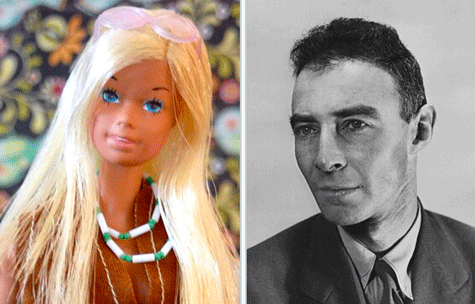Lessons from last summer’s movie hits and bombs
With the SAG strike perhaps about to end and Hollywood getting back to work, what can the entertainment industry learn from the unusual summer of “Barbenheimer?”
By Jeffrey Cole
It started as a joke and turned into one of the most successful marketing moves in the history of the entertainment industry—or any industry for that matter. There was no mastermind behind the nonsensical pairing of Greta Gerwig’s Barbie with Christopher Nolan’s Oppenheimer into the awkward moniker “Barbenheimer.”
It just worked.
 The unlikely linking of these two films was the most interesting development of the Summer 2023 movie season. There were other unlikely events that illustrated how much the theatrical business is changing while linear television and streaming struggle to determine their place in the media eco-system.
The unlikely linking of these two films was the most interesting development of the Summer 2023 movie season. There were other unlikely events that illustrated how much the theatrical business is changing while linear television and streaming struggle to determine their place in the media eco-system.
There are three major lessons for films in the Summer 2023 movie season:
Lesson 1: Barbenheimer
If this blending of two of the most incongruent stories imaginable had been planned, it would have been a trainwreck of colossal proportions. In no one’s fertile imagination could there be a connection between a) a light-hearted story (with a message) of a beloved (and sometimes reviled) childhood toy with impossible body dimensions and b) the story of the birth of the atomic bomb and its political repercussions.
No studio or advertising agency concocted this lamebrained but wildly successful scheme. It came from fans using social media to spread the idea of integrating two of the most anticipated movies of 2023. Barbie came from Warner Bros Discovery and Oppenheimer from Universal.
Until 2022, Christopher Nolan had maintained a long, successful relationship with Warner: directing the Dark Knight Batman series, Inception, and Interstellar. Only when he became frustrated with Warner’s delay releasing Tenet in the middle of the pandemic did he move his shingle to Universal.
If both films had come from Warner, the studio chiefs would have immediately re-scheduled one of them to a different day or month, not wanting to compete. Only an outsider could see logic of opening both films on the same day.
Movie fans responded to the weirdness of the shared release date. They knew that they were leading the Barbenheimer idea, rather than responding to a planned marketing campaign.
Barbie had more momentum. Oppenheimer benefited from Barbenheimer as fans added seeing Nolan’s film to Gerwig’s—in millions of cases making it a double feature on the same day. Everyone knew Barbie. Few had ever heard of Oppenheimer, but they wanted to be part of the excitement.
Unsurprisingly, many fans wore Barbie’s signature pink to see Gerwig’s film. Adding to the utter strangeness, some dressed as Robert Oppenheimer (pork pie hat and pipe).
The results were extraordinary. Barbie became the highest-grossing movie of the year. The studio now expects it to gross over $1.5 billion, making it the most successful film in Warner’s history. Oppenheimer, a three-hour historical film, was predicted to bring in about $300-400 million. Through the linkage to Barbie (and its own quality), it will reach $1 billion.
This was an extraordinary phenomenon. However, Barbenheimer is not replicable. It is a black swan event. It was eccentric fans who saw the silliness of combining the films. The linkage felt authentic. A marketing team behind the move would have felt manipulative.
Warner, Universal, and movie theaters should count their blessings. This will likely never happen again. Some fans saw that Paw Patrol: The Mighty Movie (a children’s film) was opening on the same day, September 29, as Saw X, the grisly horror sequel. There was a feeble attempt to integrate them as SawPatrol. It made no sense, seemed in bad taste, and (fortunately) never caught on.
There is one lesson from the unlikely and spectacular success of Barbenheimer: the love of movies on a big screen is alive and well. Fans will flock to movie theaters to see an original film with a great concept (especially if there is no Roman numeral in the title).
Which brings us to the second lesson.
Lesson 2: Too many Summer 2023 movies were bloated, too expensive, too long, and (in many cases) unwanted sequels
Between mid-June and mid-July (up to Barbenheimer), a number of major films opened to weekend grosses of $50-80 million. On a different planet, this would have been cause for celebration. The problem was that these films cost between $200-300 million to make and another $100-125 million to market and advertise.
Studio films need to make double their costs to break even, so these films had to earn between $550 million to $800 million to earn a profit.
None did. Most didn’t even come close, losing $100-250 million each.
Which movies?
- Warner’s The Flash cost $200-300 million to make and another $100 million to market. It needed to gross $700 million, instead it stalled at about $260 million.
- Disney’s The Little Mermaid cost $250 million to make with marketing costs of $150 million. It needed to gross $800 million instead of the $560 million it made.
- Disney’s Indiana Jones V cost $300 million to make and $100 million to market. It grossed $375 million instead of the $800 million to break even.
- Paramount’s Mission Impossible VI cost $291 million to make and $150 million to market. It needed over $800 million instead of the $567 million it grossed.
- Disney’s Haunted Mansion cost $150 million to make and $125 million to market. It grossed $114 million but needed $500 million to earn its costs.
These five films lost around $1.5 billion with more than half of the loss coming from Disney.
All the films were either sequels, remakes (The Little Mermaid) or based on highly familiar concepts (Haunted Mansion, The Flash).
Ultra-high production budgets become an anchor on a film, requiring it to become one of the most successful films of the decade just to break even: this is an impossible burden. It worked when Marvel’s superheroes were at the peak of popularity and animated classics were hot properties to remake as live action stories. It also worked when what are now sequels were new and fresh.
The unlikely linking of Barbie and Oppenheimer was the most interesting development of the Summer 2023 movie season. There were other unlikely events that illustrated how much the theatrical business is changing while linear television and streaming struggle to determine their place in the media eco-system.
The lesson is clear: there should only be a handful of massively expensive films each year. Such movies must also be compelling story ideas, mostly original, rather than tiresome retreads. Disney cannot seem to make anything other than a $200 million film. They have a massive machine that eats another $100 million every time it has something to market. The bigger-is-better strategy worked in the glory days of Marvel, Star Wars, and Pixar. Post-COVID, it needs rethinking.
Lesson 3: The Sound of Freedom
Perhaps without realizing it, Angel Studios internalized Lessons #1 and #2.
Sound of Freedom, loosely inspired by a true story about a Homeland Security agent fighting child trafficking in Central America, was an original story produced on an emaciated budget (by Hollywood standards).
Although Disney inherited the rights from Fox when it purchased the studio, it passed on making the film. They may have been appropriately concerned about the sensitive subject matter, but it also would not squeeze into the Disney movie machine.
Critics, especially on the left, argued that Sound of Freedom was a religious film with QAnon messages, complete with a white savior. There is indeed a white savior. But even though Angel Studios makes religious films, there were no religious messages in Sound of Freedom. While QAnon may have liked that the film tackled child trafficking, there were no conspiracy theories or QAnon references.
Churches and other groups endorsed the theme and message of the film. They encouraged members to see it. In some cases, they organized outings complete with transportation. They urged wealthier members to pay it forward and buy tickets for others.
The results were spectacular, especially when compared to the budget and grosses of the five movies I discussed earlier: it has sold over $200 million in tickets.
Sound of Freedom cost an astonishingly low $14.5 million to make (less than the cost of some one-hour television programs). Its marketing budget (not as essential because so much attention came from viral campaigns) was crowd-sourced at $5 million.
There is nothing about the Sound of Freedom model that is limited to conservative or religious viewers. Barbie and Oppenheimer proved that people are hungry for original stories. Those can be made for far less than $200 million if they are not part of a studio machine.
In the fall, we will see two hugely expensive (and long) films: Martin Scorsese’s Killers of the Flower Moon and Ridley Scott’s Napoleon. Like Barbenheimer, both are original, high-profile films. Interestingly, both films are produced by Apple (but Paramount will distribute Killers and Sony will distribute Napoleon).
Losses like what the other studios experienced last summer will be rounding errors to Apple.
Perhaps Apple is taking over the very high end of the theatrical movie business.
____________

Jeffrey Cole is the founder and director of The Center for the Digital Future at USC Annenberg.
See all columns from the center.
October 11, 2023

